Updated Dec. 20, 2024
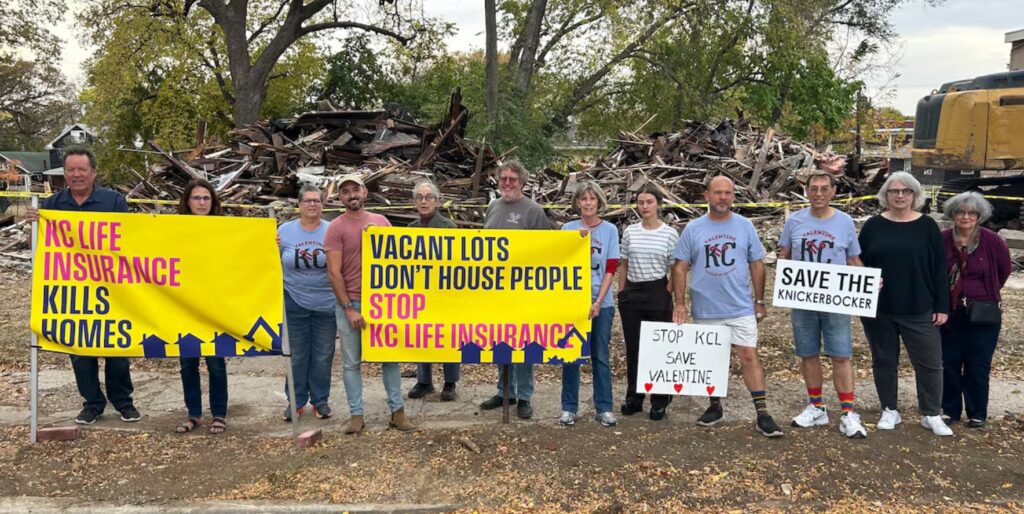
Demolitions continue in the Valentine neighborhood between 33rd and 35th from Pennsylvania to Southwest Trafficway. The Valentine Neighborhood says 23 homes and other structures are being demolished without a plan for what will replace them. According to a recent historical survey of the area, all of these structures would have qualified for addition to the historic register. In October, Kansas City Life Insurance, which owns the homes, told the Kansas City Star that it was removing “vacant and non-viable buildings” from its property. Instead, they have been reduced to piles of rubble.
A new group called Save Valentine has formed to monitor the demolitions and advocate for future land use in the area that benefits the neighborhood and the community. The group is also distributing yard signs.
News Coverage
- Fox 4 News: Valentine Neighborhood mourns demolitions, prepares for more
- KSHB 41: Residents in Kansas City’s Valentine neighborhood hold memorial for demolished homes
- KC Star: Valentine Demolitions Part of Discussion on Vacant Lot Tax
- The Beacon: As Kansas City Life flattens houses in the Valentine neighborhood, residents anxiously await what’s next
Demolitions: House by House
We have documented the homes as they are being torn down side-by-side with how they looked just a few years ago.

3421 Summit (seen as it looked just a few years ago and as it looks today). The home was an American Foursquare built in 1903, and according to a recent historical survey of the area, it would have qualified for addition to the historic register. Instead, it has been reduced to a pile of rubble.

3431-33 Summit (seen as it looked just a few years ago and as it looks today). The building was a vernacular-style duplex built in 1910 by E.C. Peterson, who also built 3427 Summit and other homes, including one in Coleman Highlands. The building was an example of an Historic Colonnaded Apartment.

3417 Jefferson. This 2021 photo on the left shows signs of a family living in the home, which has now been demolished. The building was a Kansas City shirtwaist, like many of those across Midtown. It was built in 1910 by J.B. Curry, the chief clerk of the Union Pacific Railroad.

3418-20 Pennsylvania, seen in this 2021 photo. (The original address was 3422 Pennsylvania). From the late 1930s through the early 1960s, members of the Egan family called the duplex home. The first to be listed as living there was Mrs. Bridgett Donahue (nee Egan). Her brothers Thomas and John Egan lived nearby at 444 W. 34th Terrace. John Donahue was a pipe fitter who later became the chief deputy in the city clerk’s office. He died in 1959, and in 1963, Thomas Egan was living in the Pennsylvania home. Like many residents of the area, they were members of the Redemptorist Church at Linwood and Broadway.

3419 Jefferson. This 2021 photo on the left shows the American Foursquare home when it was still occupied. It was built in 1904 for Edward Mangan, who, like many of the area’s early residents, was part of the Irish immigrant community. These Irish-American families gathered in the area known then as Redemptorist Parish, the area surrounding Our Lady of Perpetual Help Church (also known as Redemptorist) at 33rd and Broadway.
Edward Mangan, born in Ireland, was a prominent member of the Kansas City community. He worked as the chief weighmaster of the Kansas City Stockyards Company, as a deputy sheriff, then as the county account, and later became a gas station inspector.
The 1910 census shows that he and his wife Mary lived at 3419 Jefferson with four daughters and three sons. The Mangan’s most immediate neighbors on the block were almost all the children of Irish immigrants.
One of the Mangan children, Edward, would become a priest known as one of the leading Biblical scholars of the Catholic church. He would remember playing shinny and corner lot baseball near his home at 34th and Jefferson.

3422 Pennsylvania. This 2021 photo on the left shows the home before demolition, which is shown in the photo on the right.
Many of those who settled in this area were Irish immigrants, but a recent immigrant from Sweden owned this home. Louis Johnson had the house built in 1908, and by 1910, the 33-year-old carpenter was living there with his wife Ingrid, a son, and two boarders. Louis was a cabinet maker. He turned to another Swedish immigrant, Swan Johnson, to build the home. Swan Johnson was a carpenter and contractor who built several houses in Midtown. He also built the Broadway Baptist Church.
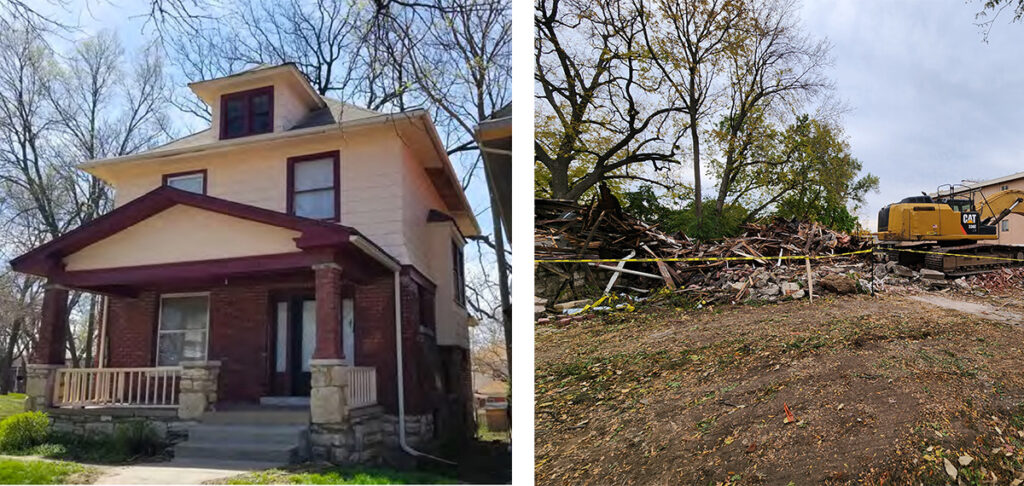
3424 Pennsylvania. This 2021 photo on the left shows the home before demolition, shown after the demo in the photo on the right.
When bench-builder Henry Ostrum built the home, he was 32 years old and shared it with his wife Ellen, two sons, a daughter, his mother-in-law, and a boarder. Ostrum had been born in Missouri to parents who had immigrated from Sweden.
By the late 1920s, the Edward Quinn family had moved into the home, where they would remain at least through the late 1960s. Quinn’s father had been an apprentice bootmaker in Ireland and opened a boot shop in Kansas City in about 1880. Edward was a police sergeant who later was “on duty” at the nearby Norman School.

3421 Jefferson. This 2021 photo on the left shows the apartment before demolition, shown after the demo in the photo on the right.
Small apartments like this one, built in 1923, offer excellent opportunities to provide affordable housing to Kansas City individuals and families. Preservation experts point out the value of these buildings across the city, many of which have been rehabbed by developers. Smaller apartment buildings are often overlooked as a “missing middle” option for providing housing, even though they offer the greenest alternative to housing. That’s because the greenest building is one that already exists.
This duplex colonnaded apartment was built in 1923 by the Kelley Realty Company. While most of the single-family homes on the block were built in the first decade of the 1900s, a number of small to medium-sized apartments filled in vacant lots that were available in the 1920s. They filled a need for affordable rental property, and over the years, hundreds of different individuals and families would call 3421 Jefferson home. According to a 1925 advertisement, it offered “5 room efficiency, porch, steam heat” and even a janitor.

3440 Jefferson. This 2021 photo on the left shows the home before demolition, the photo on the right shows the site after demo.
This 1909 Craftsman bungalow was built by J. E. Marshall. The first owner is recorded as Scott Godley. In 1910, it was described for rent as an “elegantly furnished bungalow.” While not much information shows up in the records, The Pitch in 2001 called it “one of the best-kept secrets in the arts community,” when it was the Flake Gallery located in William Howell’s home.

614 W. 35th. This 2021 photo on the left shows the home before demolition, the photo on the right shows the site after demo.
614 W. 35th was a shirtwaist built in 1904 or 1905 with a great wrap-around front porch. Among its earliest owners was the Jack family, headed by widow Mary G. Jack, who was 50 years old in 1910. Mary had six children. Three were public school teachers, and one was a nun. One of her sons owned a drugstore. Mary was also an officer in the Royal Neighbors of America, Queen of the Valley Camp. Royal Neighbors of America was founded as a ladies’ auxiliary group to Modern Woodmen of America in 1888.
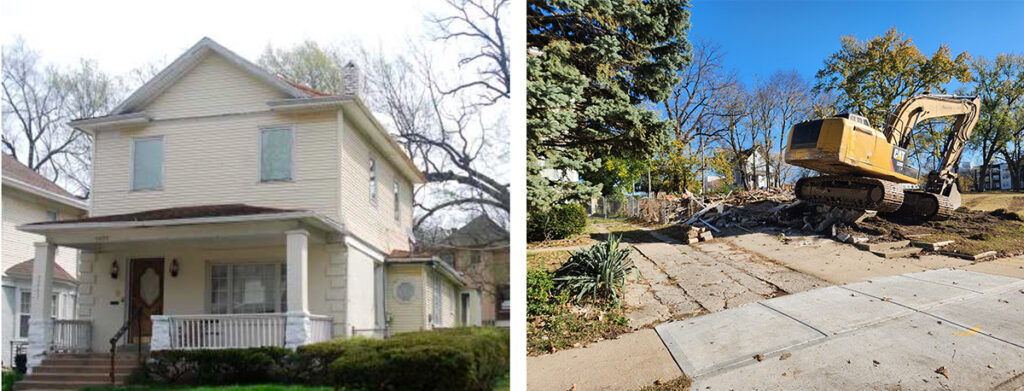
3427 Jefferson. This 2021 photo on the left shows the home before demolition, and the photo on the right shows the site after demo.
In 1971, the residents of this home at 3427 Jefferson told the Kansas City Star they were afraid “big money interests” would take away their home and their entire neighborhood after Kansas City Life Insurance announced a plan to redevelop the area. see the KC Star article from 1971
Last week, the home was torn down.
The home was built in 1905 by John Foley, a carpenter. For many years, it was the home of the Lopez family.
Kansas City Life Insurance announced a plan in 1971 for the Penn Valley Plaza redevelopment, which proposed to declare the area between 33rd Street and Valentine Road from Pennsylvania to Southwest Trafficway blighted, so that the homes there could be demolished to make way for high-rise office buildings and apartments. The Valentine Neighborhood Association was formed that year to fight the proposed demolition.
The Lopez family gave a Kansas City Star reporter a tour of their home on March 27, 1971. “We’ve been working on this house for 20 years,” Mrs. Alfred Lopez said. Like many of their neighbors, they had lived in the home for 20 years and fixed up each room of the home themselves. They didn’t want to move. City hearings on the project brought out scores of citizens from across Kansas City and became a key issue in city elections that year.
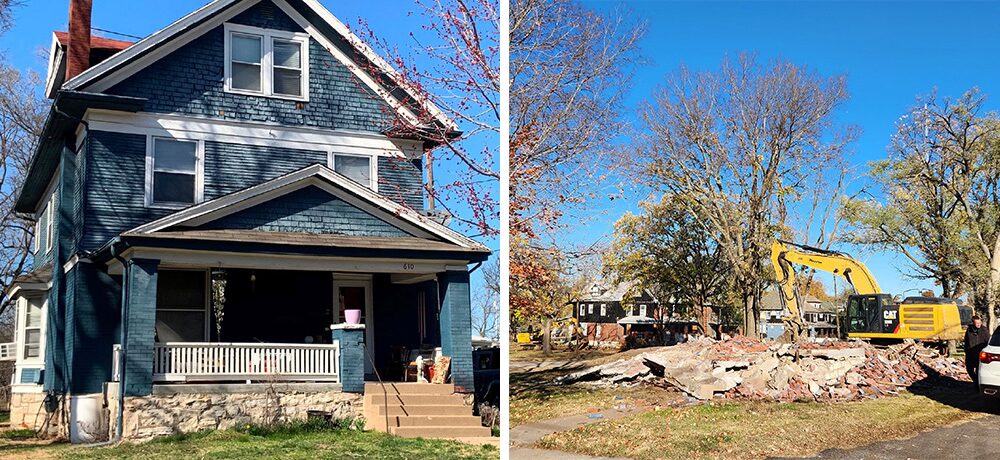
610 W. 35th. This 2021 photo on the left shows the home before demolition, and the photo on the right shows the site after demo.
When it was first built in 1904, this home was occupied by the James R. Knox family, who also rented out a large room for “1 or 2 desirable gentlemen.” Knox was the manager of the hide department at Armour and Co. He died in 1916 when his boat overturned in a local lake.
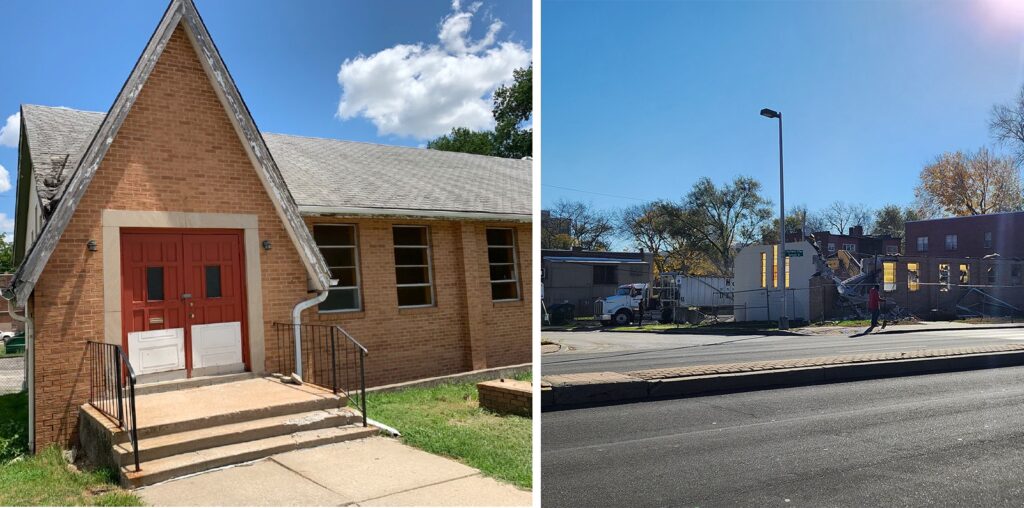
3401 Summit. This 2021 photo on the left shows the church before demolition, and the photo on the right shows the site after demo.
The church was built in 1963 by Genero Lopez and designed by architect Lawrence Jones. The vernacular building operated as El Buen Pastor Baptist Church from that year until about 2006.

3414 Jefferson. This 2021 photo on the left shows the home before demolition, and the photo on the right shows the site after demo.
Kansas City American Foursquare was built in 1905 by Lane Brothers. It first went on the market as a rental home that year, and among others, the family of policeman Thomas J. Bartlett lived there. In 1920, the house was sold to Mr. and Mrs. Charles Stanley. Charles was a professional baseball player and pitched for the Kansas City Blues. Records show the Stanleys living in the home through the early 1980s.
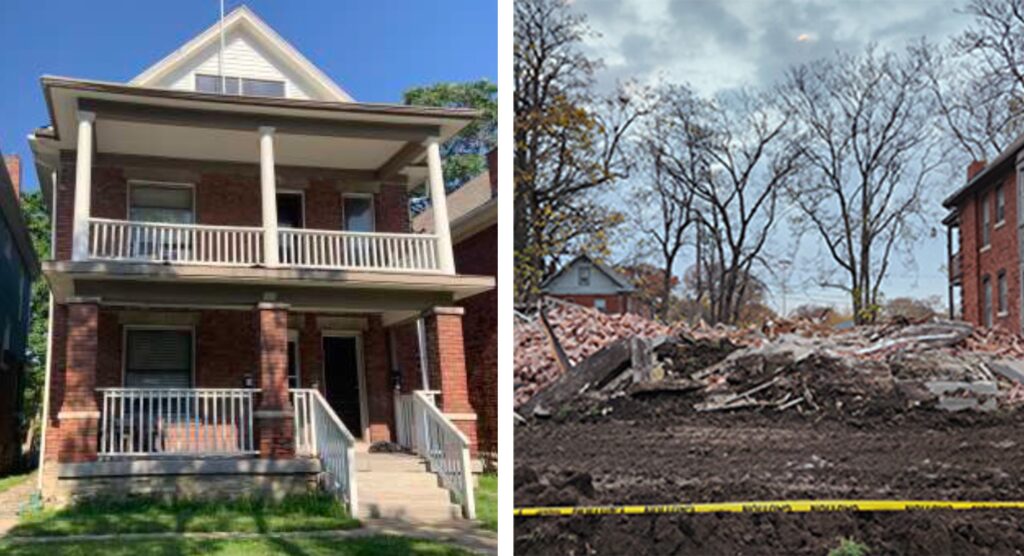
3436 Jefferson. This 2021 photo on the left shows the home before demolition, and the photo on the right shows the site after demo.
This home, a duplex, had been providing housing since 1905. 3436 Jefferson was built that year by H. Bert Hendrick, a local plumber, who lived in half the duplex and rented the other half.
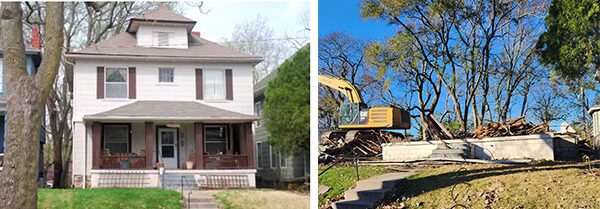
3426 Jefferson. This 2021 photo on the left shows the home before demolition, and the photo on the right shows the site after demo.
This American Foursquare home, built in 1906, was first occupied that same year by John T. Duff. Duff, in the early 1900s, was the proprietor of a saloon called Landers and Duff, which he ran with his brother-in-law, Thomas Landers, who lived next door at 3428 Jefferson. The Duffs are listed at this address through the 1930s.

3428 Jefferson. This 2021 photo on the left shows the home before demolition, and the photo on the right shows the site after demo.
This Kansas City Shirtwaist became home to the Thomas E. Landers family when it was built in 1905. Landers, at that time, owned a saloon with his brother-in-law, John Duff, who lived next door at 3426 Jefferson.
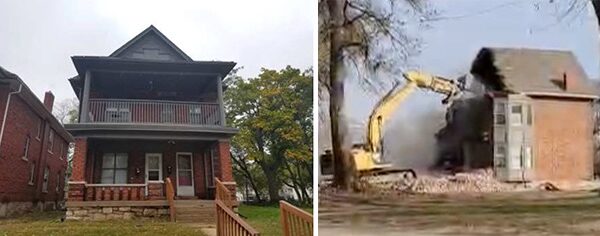
3434 Jefferson. This 2021 photo on the left shows the home before demolition, and the photo on the right shows the site during demo.
This duplex was an American Foursquare-style, two-story home built in 1912 by H. Bert Hedrick. Hedrick, a plumber, also built the home next door at 3436 Jefferson. Some newspaper accounts list Hedrick as living in this home, and others have him living next door. Either way, the family lived on the block through the end of the 1940s.

3416 Pennsylvania. The photo on the right shows the apartments as they looked in 2021, and the photo on the left shows the lot after demolition.
This modern apartment building, constructed in 1962, is among 23 building recently demolished in the Valentine neighborhood. The property at 3416 Pennsylvania was one of the more modern in the area, built in 1962 as a six-unit apartment building by Kernes Quality Homes.

Before the modern apartment stood on this site, it was occupied by a home built around 1906, seen as it looked in 1940.
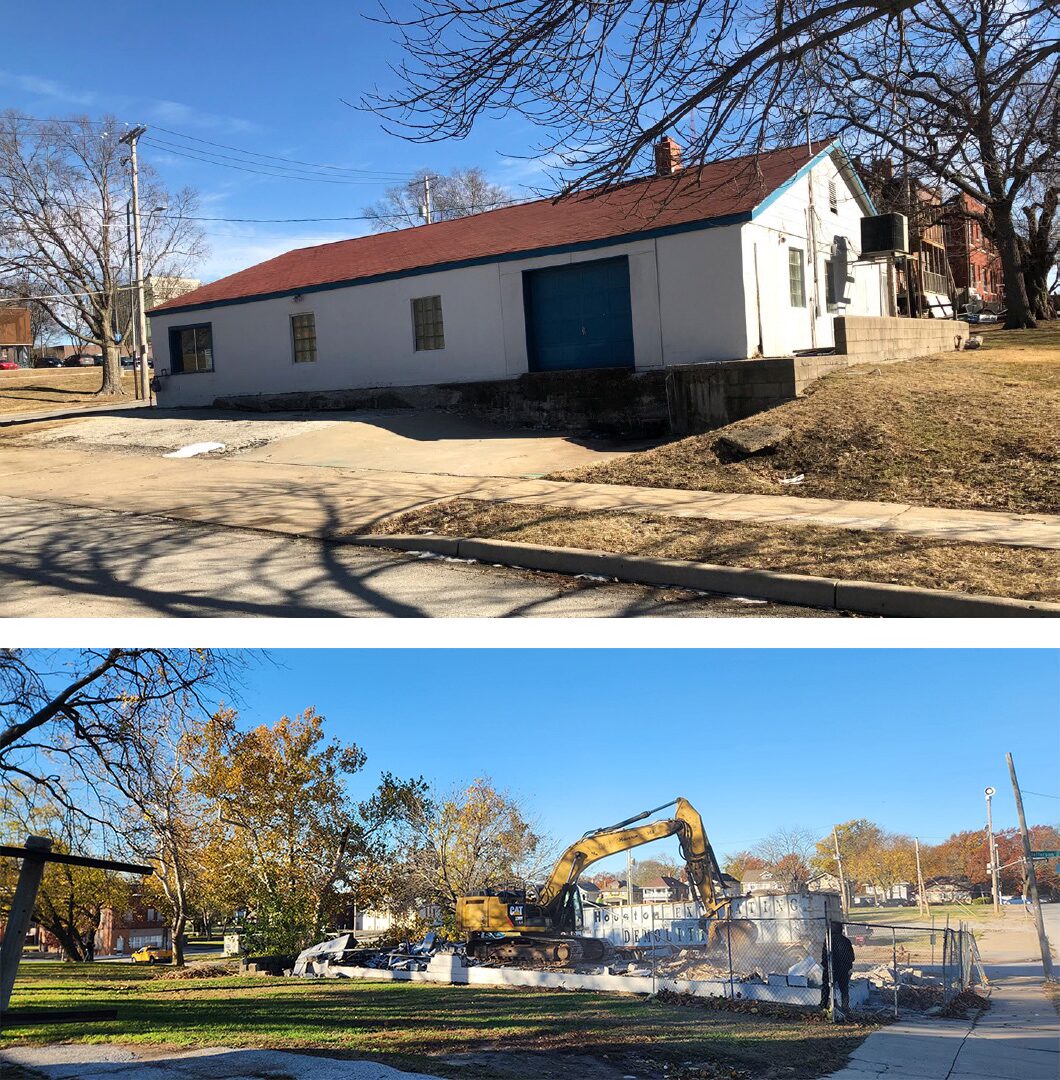
621 W. 33rd. The photo on the top shows the commercial building as it looked in 2021, and the photo on the bottom shows the lot after demolition.
One of the buildings that has been recently demolished was a small structure that served as a neighborhood business. The small shop at 619 W. 33rd Street was built in 1946 by Martin McCoy and would house several different businesses. When it opened, it was an auto body repair shop. Later, the building was used as a printing shop and a tile and stone warehouse.

3443 Jefferson. The photo on the right shows the house as it looked in 2021, and the photo on the left shows the lot after demolition.
The two-story frame craftsman bungalow was built in 1915 by E.C. Clark. Only a little information about the families who lived there could be found in a search of newspaper records.
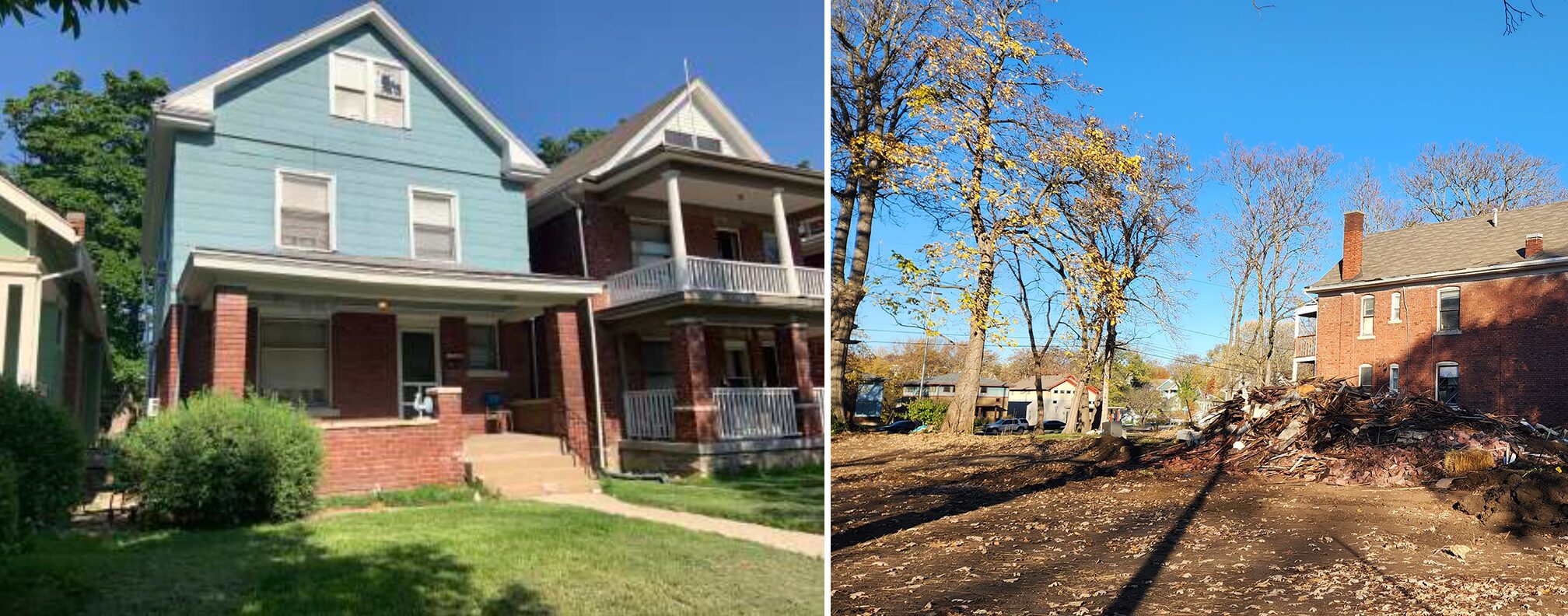
3438 Jefferson. The photo on the right shows the house as it looked in 2021, and the photo on the left shows the lot after demolition.
Although it was built in 1907, this home was advertised as a sturdy, well-built structure with 10 large rooms. It was a Kansas City shirtwaist, a popular local style that features exposed brick or limestone on the first floor and upper levels of another material such as wood frame or stucco.
Shirtwaists are a unique Kansas City style, and many people across the city have renovated and preserved these homes.
In 1910, Rose Perryman, a 60-year-old window, was the head of the household. She was born in Virginia in 1850 to parents who had immigrated from Ireland. She married an Irish immigrant and had three daughters and two sons, also living in the home when the census was taken that year. Rose worked as a stenographer. Her son Edward worked as a railroad yard clerk, and son John was a clerk at a packing company. Daughters Margaret and Rose worked as stenographers.

3441 Summit. The photo on the right shows the house as it looked in 2021, and the photo on the left shows the lot after demolition.
A Kansas City police detective lived at the recently demolished duplex on Southwest Trafficway for more than three decades. The two-story brick building is among nearly two dozen recently demolished in the Valentine neighborhood.
The duplex, built in 1910, was originally owned by James H. Todd. Todd lived there until he died in 1941. He rose through the ranks of the Kansas City police department to become a detective. His wife, Mary, died in the home in 1933.